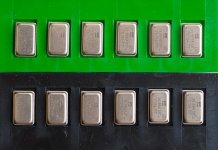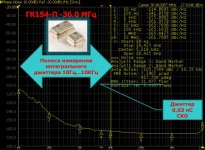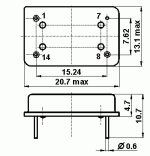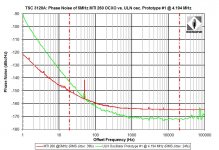Ultra-low jitter oscillators 22.5792, 24.5760, 33.8688, 36.8640, 45.1584, 49.1520 MHz
Ultra-low jitter clock generators ГК154-П-Т, made in Russia, http://bmgplus.ru/images/pdf/pdf154T.pdf , DIL-14 packaging, 5V supply, tristate mode. The really best oscillators for audio.
Pin 1 Open or '1' level - Enabled, '0' level - high impedance, Pin 7 - ground, Pin 8 - output, Pin 14 - Pover supply.
512Fs - 22.5792 MHz, 24.5760 MHz, 768Fs - 33.8688 MHz, 36.8640 MHz, 1024Fs - 45.1584 MHz, 49.1520 MHz
52$ one oscillator
33.8688 MHz temporarily unavailable. But pllease let me know if you need this item
Alsou is possible to produse ГК155-П-Т - 3,3V supply version, but it takes very long time.
Also
Digital filter
AD1896AYRSZ - 14$
DACs
AD1955ARSZ - 10$
AD1852JRSZ - 9$
Op Amps
OP42FJ TO-99 metal can - 17$
OP42GPZ DIP8 - 9,5$
LT1122ACN8 DIP8 - 10$
AD823AARZ SOIC8 - 6$
AD811ANZ DIP8 - 9$
AD844ANZ DIP8 - 10$
AD845KNZ DIP8 - 16$
AD815ARBZ - 10$
OP484ESZ SOIC14 QUARD OP AMP - 16$
LT1217CN8 DIP8 - 6,5$
Voltage References
AD586MNZ DIP8 - 9$.
AD586BRZ SOIC8 - 9$
ADR4550ARZ - SOIC8 - 5$
EPM7128STC100-10 CPLD - 12$ Embedded - CPLDs (Complex Programmable Logic Devices) | Integrated Circuits (ICs) | DigiKey
Shipping from Russia 10$ - 12$
Paypal, VISA, other variants can be negotiated
11 oktober 2020 edited, list is aktual
Ultra-low jitter clock generators ГК154-П-Т, made in Russia, http://bmgplus.ru/images/pdf/pdf154T.pdf , DIL-14 packaging, 5V supply, tristate mode. The really best oscillators for audio.
Pin 1 Open or '1' level - Enabled, '0' level - high impedance, Pin 7 - ground, Pin 8 - output, Pin 14 - Pover supply.
512Fs - 22.5792 MHz, 24.5760 MHz, 768Fs - 33.8688 MHz, 36.8640 MHz, 1024Fs - 45.1584 MHz, 49.1520 MHz
52$ one oscillator
33.8688 MHz temporarily unavailable. But pllease let me know if you need this item
Alsou is possible to produse ГК155-П-Т - 3,3V supply version, but it takes very long time.
Also
Digital filter
AD1896AYRSZ - 14$
DACs
AD1955ARSZ - 10$
AD1852JRSZ - 9$
Op Amps
OP42FJ TO-99 metal can - 17$
OP42GPZ DIP8 - 9,5$
LT1122ACN8 DIP8 - 10$
AD823AARZ SOIC8 - 6$
AD811ANZ DIP8 - 9$
AD844ANZ DIP8 - 10$
AD845KNZ DIP8 - 16$
AD815ARBZ - 10$
OP484ESZ SOIC14 QUARD OP AMP - 16$
LT1217CN8 DIP8 - 6,5$
Voltage References
AD586MNZ DIP8 - 9$.
AD586BRZ SOIC8 - 9$
ADR4550ARZ - SOIC8 - 5$
EPM7128STC100-10 CPLD - 12$ Embedded - CPLDs (Complex Programmable Logic Devices) | Integrated Circuits (ICs) | DigiKey
Shipping from Russia 10$ - 12$
Paypal, VISA, other variants can be negotiated
11 oktober 2020 edited, list is aktual
Attachments
Last edited:
If the parts are reliably in this ballpark (-115@10Hz) this product is shockingly better than all the applauded Crystek's.
Edit:
It would certainly be helpful to see data which goes lower down in frequency, 1 Hz or even 0.1 Hz.
>1kHz can be omitted anyway, it's of no significance.
Edit:
It would certainly be helpful to see data which goes lower down in frequency, 1 Hz or even 0.1 Hz.
>1kHz can be omitted anyway, it's of no significance.
Last edited:
ГК154П-Б 24.576MHz, mesured by Agilent E5052 on frecuency detuning 100HZ has noise spectral density -135дБ, but Crystek CCHD957 24.576MHz mesured in the same conditions -124.5дБ
5v oscillators has better parameters than 3.3v versions of the same oscillators, and this is for any brands.
5v oscillators has better parameters than 3.3v versions of the same oscillators, and this is for any brands.
Now i am puzzled. Why people still asking for 1Hz figure? Ain't 10Hz enough? You can see the noise characteristic asymptotes on the supplied chart and extrapolate on these...
When using chorus, flanger and phaser effects as an active musician and audio engineer my practical experience always was, that human ear is extremely sensitive to modulation to pitch/phase at a rate of 1..10Hz with a peak at perhaps 4Hz.
This was already a known fact in audio engineering of the 60ies and 70ies, when Wow & Flutter (the jitter of the analog age) measurement standards like IEC 386 were established for record and tape players.
https://en.wikipedia.org/wiki/Wow_and_flutter_measurement
These measurements used weighting filters, which pronounced that very frequency range with a peak around 4..5Hz.
Later work by digital audio/jitter pioneers like Julian Dunn then stressed, that phase noise in digital audio should be kept very low at rather high frequencies (1kHz..20kHz) leading to an ultimately low (audio band RMS) jitter figure. This needs to be taken with a grain of salt, since all good and affordable audio oscillators have their 1/f corner frequency (where the noise floor starts rising) just in the range of 200..2000Hz (surprise). So this could have been a pretty opportunistic claim, because you simply don't get much better below these frequencies, if you don't want to use extremely expensive SC-cut crystals or lens shaped BT cut crystals in the 5MHz range etc..
I think both standpoints are valid. I'm also pretty sure that -90dBc at 4Hz (as a sine modulation) could be clearly audible, since the best record players reach such a level of W&F, so it is at least interesting to know what is going on there in the W&F region.
Please find enclosed phase noise plots of a commercial MTI 260 SC-cut double OCXO (Which is among the perhaps three very best
 commercially available oscillators regarding close-in phase noise in the world) and a designed by myself oscillator using two series connected (matched) High Q BT-cut lens crystals.
commercially available oscillators regarding close-in phase noise in the world) and a designed by myself oscillator using two series connected (matched) High Q BT-cut lens crystals.From these two noise plots you can also see, that both oscillators have differently steep curves in the range of 1...10Hz (They have different orders and bent slopes). So it is always quite interesting to see, what is going on there. Both oscillators would be indeed great audio oscillators, if they had the right frequencies or drive a DAC with an ideal ASRC.
Anyhow, if these Russian oscillators are that good as the phase noise plot in the first post suggests, they are really a great alternative, especially since probably no DAC chip in the world would be good enough (lower inherent phase noise) to be a match.
Did any second, independent source confirm the phase noise of these Russian oscillators ?
Attachments
Last edited:
I had, but now all of them are sold, may be i will have again 3.3V versions for sell, but not soon.@KAISER_nsk Do you have 3.3V versions of the 49.1520 and 45.1584 generators?






